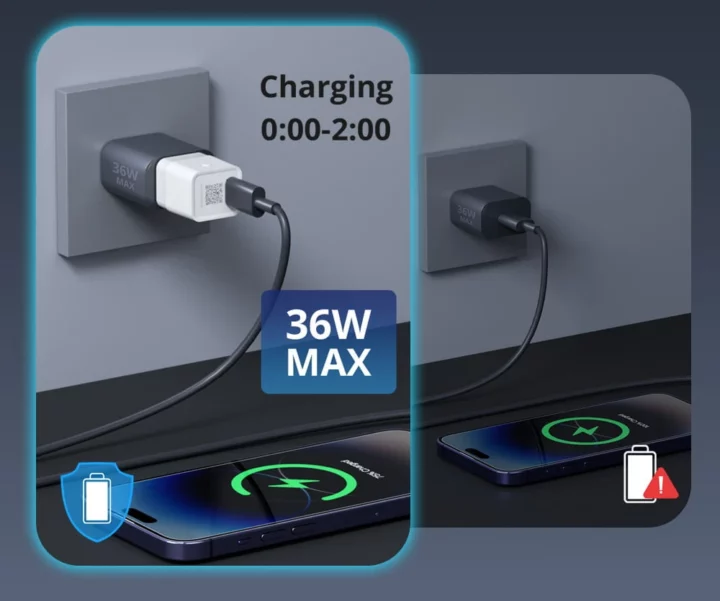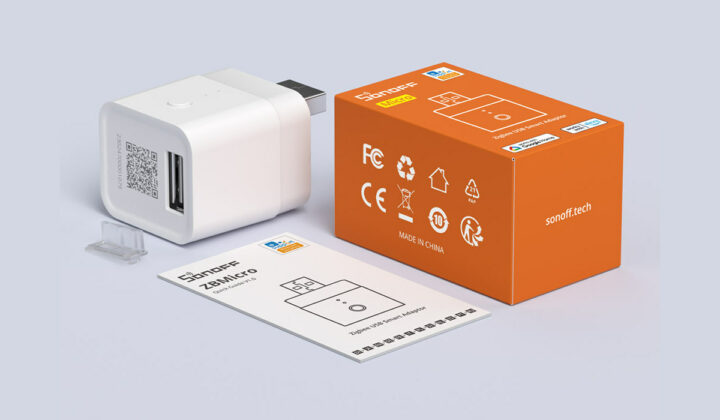SONOFF Micro Zibgee USB Smart adapter, or SONOFF ZBMicro for shorts, is a Zigbee 3.0 USB adaptor to remotely control USB devices via your smartphone app or home automation solution based on Home Assistant or other solution to turn on/off the device, set timers to control charging times, configure smart scenes, or control with voice commands.
The new home automation device from ITEAD is based on a Silicon Labs EFR32MG21 multiprotocol SoC, works with the usual eWelink app, as well as Home Assitant and OpenHAB open-source solutions when the server is fitted with a compatible Zigbee 3.0 USB dongle
SONOFF ZBMicro specifications:
- Wireless MCU – Silicon Labs EFR32MG21
- MCU core – Arm Cortex-M33 microcontroller @ 80 MHz
- Memory – 96KB SRAM
- Storage – 352KB flash, 1024KB ROM for protocols and library functions
- Wireless – Zigbee 3.0
- USB – USB 2.0 Type-A port
- Misc
- User Button – single press: Turn on/off the smart device; Press and hold for 5 seconds: the device enters the pairing mode.
- Network LED indicator (Green) – Steady on: Normal connection with the gateway; slow flash: the device is in pairing mode; fast flash: abnormal connection with the gateway
- Power LED indicator (Red)
- Power Supply
- Rating – 5 to 22V up to 4.6A
- Rated Power – 36W MAX (with QC 3.0 Adaptor)
- Support for QC 3.0, FCP, SCP, PE, AFC, Apple 2.4A
- Dimensions – 33 x 31 x 26.5mm
- Weight – 17.6 grams
- Casing Material – PC
- Temperature Range – -10°C to 40°C
- Humidity – 5-95%RH, non-condensing
- Compliance – CE, FCC, ISED, RoHS
- Safety – EN IEC 62368-1

The SONOFF ZBMicro requires a Zigbee 3.0 hub such as the SONOFF iHost, SONOFF NSPanel Pro, Echo Plus 2nd, Philips Hue, or SmartThings hub V3… It works with the eWelink mobile app, but it is also compatible with open-source automation platforms such as Home Assistant with Zigbee2MQTT integration and openHAB as long as those are fitted with a compatible Zigbee Dongle such as the SONOFF ZBDongle-E or the SkyConnect USB stick. ITEAD also explains the ZBMicro can work as a Zigbee router to extend the range of your Smart Home Zigbee network. A user manual is available but with limited information.
ITEAD sells the SONOFF ZBMicro for $12.99 plus shipping, but as usual, you can get a 10% discount when using the coupon code CNXSOFTSONOFF, and orders over $89 get free shipping. Paisit will soon get a sample along with the upcoming ZBbridge-U “Zigbee Bridge Ultra and Matter Bridge” supporting up to 256 Zigbee sub-devices, so you can expect a review within the next few weeks on CNX Software.

Jean-Luc started CNX Software in 2010 as a part-time endeavor, before quitting his job as a software engineering manager, and starting to write daily news, and reviews full time later in 2011.
Support CNX Software! Donate via cryptocurrencies, become a Patron on Patreon, or purchase goods on Amazon or Aliexpress






A bit expensive when the XY-WFUSB is around and can be flashed with Tasmota/ESPHome/Espurna, can act as a PWM controller when flashed with a custom firmware and supposedly supports up to 100W of power delivery.
Ok, Sonoff’s is Zigbee. Nice.
I do prefer the form factor of this device over the XY-WFUSB.
Thanks for mentioning the XY-WFUSB, I agree it looks much more promising.
But AFAICS it doesn’t support any kind of power metering, just like the ZBMicro… if it did, then it would be perfect for a use case of mine.
Do you happen to know any similar devices that do?
Not seeing the benefit over using a “standard” mains voltage plug adaptor, plus it would have the advantage of turning off the USB charger as well
I have been using something similar for voltage ranges 5-12V and 2.5A for my USB lights. It was not a problem to get 5V 10W light which is strong enough. It uses a Wi-Fi connection and is linked to the Smart Life cloud system.
This one has just only 1 LED and it is also compatible with TUYA while the other WiFi one has 2 LEDs and is compatible with EWeLink. So you need to be careful.
Pricewise they are cheaper than the reviewed piece however you are not dependent on a cloud and the internet connection malfunctions or glitches. And who knows how long these cloud services will run?
I kind of don’t see the point. You still need the add a USB charger, it’s just in front of it. The same xan be accomplished with a normal mains smart switch and the USB charger plugged in after it… What advantage does this new product give?